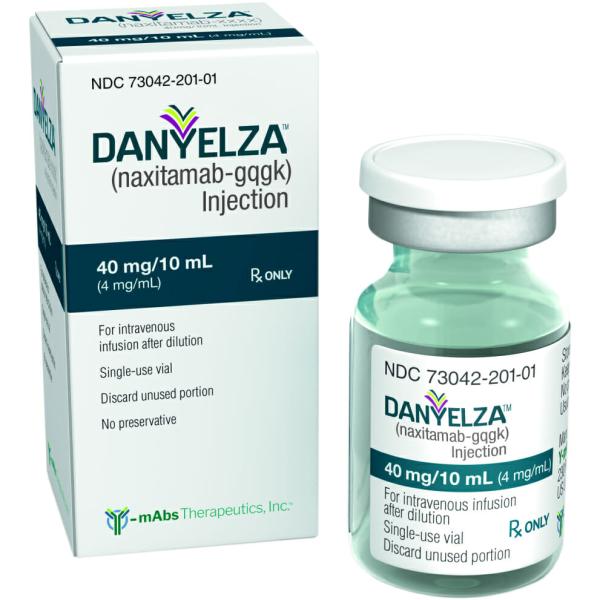Naxitamab Dosage
Medically reviewed by Drugs.com. Last updated on Jan 27, 2025.
Applies to the following strengths: gqgk 4 mg/mL
Usual Adult Dose for:
Usual Pediatric Dose for:
Additional dosage information:
Usual Adult Dose for Neuroblastoma
3 mg/kg/day (up to 150 mg/day) IV on Days 1, 3, and 5 of each cycle in combination with GM-CSF subcutaneously
NOTE: For the first infusion (Cycle 1, Day 1), administer over 60 minutes; for subsequent infusions, administer over 30 to 60 minutes, as tolerated.
RECOMMENDED DOSE REGIMEN FOR EACH TREATMENT CYCLE:
- DAYS -4 to 0: Administer GM-CSF 250 mcg/m2 subcutaneously daily beginning 5 days prior to naxitamab infusion
- DAYS 1 to 5: Administer GM-CSF 500 mcg/m2 subcutaneously daily at least 1 hour prior to naxitamab on Days 1, 3, and 5
- DAYS 1, 3, and 5: Administer naxitamab 3 mg/kg/day (up to 150 mg/day) IV
Duration of therapy: Cycles are repeated every 4 weeks until complete response or partial response, followed by 5 additional cycles every 4 weeks. Subsequent cycles may be repeated every 8 weeks. Discontinue this drug and GM-CSF for disease progression or unacceptable toxicity.
PREMEDICATIONS AND SUPPORTIVE MEDICATIONS PAIN MANAGEMENT PRIOR TO AND DURING INFUSION:
- Five days prior to the first infusion of naxitamab in each cycle, initiate a 12-day course (Day -4 through Day 7) of prophylactic medication for neuropathic pain, such as gabapentin.
- Administer oral opioids 45 to 60 minutes prior to initiation of each naxitamab
- Consider use of ketamine for pain that is not adequately controlled by opioids.
PREMEDICATION: REDUCE RISK OF INFUSION-RELATED REACTIONS AND NAUSEA/VOMITING:
- Administer IV corticosteroids (e.g., methylprednisolone 2 mg/kg with maximum dose of 80 mg or equivalent corticosteroid dose) 30 minutes to 2 hours prior to the first infusion of naxitamab.
- Administer corticosteroid premedication for subsequent infusions if a severe infusion reaction occurred with the previous infusion or during the previous cycle.
- Administer an antihistamine, an H2 antagonist, acetaminophen and an antiemetic 30 minutes prior to each infusion.
Comments:
- Refer to the GM-CSF Prescribing Information for recommended dosing information.
- Administer pre-infusion medications and supportive treatment, if needed, during infusion.
Use: In combination with granulocyte-macrophage colony-stimulating factor (GMCSF) for relapsed or refractory high-risk neuroblastoma in the bone or bone marrow who have demonstrated a partial response, minor response, or stable disease to prior therapy
Usual Pediatric Dose for Neuroblastoma
1 year and older:
3 mg/kg/day (up to 150 mg/day) IV on Days 1, 3, and 5 of each cycle in combination with GM-CSF subcutaneously
NOTE: For the first infusion (Cycle 1, Day 1), administer over 60 minutes; for subsequent infusions, administer over 30 to 60 minutes, as tolerated.
RECOMMENDED DOSE REGIMEN FOR EACH TREATMENT CYCLE:
- DAYS -4 to 0: Administer GM-CSF 250 mcg/m2 subcutaneously daily beginning 5 days prior to naxitamab infusion
- DAYS 1 to 5: Administer GM-CSF 500 mcg/m2 subcutaneously daily at least 1 hour prior to naxitamab on Days 1, 3, and 5
- DAYS 1, 3, and 5: Administer naxitamab 3 mg/kg/day (up to 150 mg/day) IV
Duration of therapy: Cycles are repeated every 4 weeks until complete response or partial response, followed by 5 additional cycles every 4 weeks. Subsequent cycles may be repeated every 8 weeks. Discontinue this drug and GM-CSF for disease progression or unacceptable toxicity.
PREMEDICATIONS AND SUPPORTIVE MEDICATIONS PAIN MANAGEMENT PRIOR TO AND DURING INFUSION:
- Five days prior to the first infusion of naxitamab in each cycle, initiate a 12-day course (Day -4 through Day 7) of prophylactic medication for neuropathic pain, such as gabapentin.
- Administer oral opioids 45 to 60 minutes prior to initiation of each naxitamab
- Consider use of ketamine for pain that is not adequately controlled by opioids.
PREMEDICATION: REDUCE RISK OF INFUSION-RELATED REACTIONS AND NAUSEA/VOMITING:
- Administer IV corticosteroids (e.g., methylprednisolone 2 mg/kg with maximum dose of 80 mg or equivalent corticosteroid dose) 30 minutes to 2 hours prior to the first infusion of naxitamab.
- Administer corticosteroid premedication for subsequent infusions if a severe infusion reaction occurred with the previous infusion or during the previous cycle.
- Administer an antihistamine, an H2 antagonist, acetaminophen and an antiemetic 30 minutes prior to each infusion.
Comments:
- Refer to the GM-CSF Prescribing Information for recommended dosing information.
- Administer pre-infusion medications and supportive treatment, if needed, during infusion.
Use: In combination with granulocyte-macrophage colony-stimulating factor (GMCSF) for pediatric patients 1 year and older with relapsed or refractory high-risk neuroblastoma in the bone or bone marrow who have demonstrated a partial response, minor response, or stable disease to prior therapy
Renal Dose Adjustments
Data not available
Liver Dose Adjustments
Data not available
Dose Adjustments
MISSED DOSE:
- If a naxitamab dose is missed, administer the missed dose the following week by Day 10. Administer GM-CSF 500 mcg /m2 /day on the first day of the naxitamab infusion, and on the day before and on the day of the second and third infusion, respectively (i.e., a total of 5 days with 500 mcg /m2 /day).
DOSE MODIFICATIONS FOR ADVERSE REACTIONS:
INFUSION-RELATED REACTIONS:
- GRADE 2 (therapy or infusion interruption indicated but responds promptly to symptomatic treatment [e.g., antihistamines, NSAIDS, narcotics, IV fluids]; prophylactic medications indicated for 24 hours or less): Reduce naxitamab infusion rate to 50% of previous rate and monitor closely until recovery to Grade 1 or less; increase infusion rate gradually to rate prior to the event as tolerated.
- GRADE 3 (prolonged [e.g., not rapidly responsive to symptomatic medication and/or brief interruption of infusion]; recurrence of symptoms following initial improvement; hospitalization indicated for clinical sequelae): Immediately interrupt naxitamab infusion and monitor until recovery to Grade 2 or less; resume infusion at 50% of the rate prior to the event and increase infusion rate gradually to infusion rate prior to the event as tolerated; permanently discontinue therapy in patients not responding to medical intervention.
- GRADE 4 (e.g., life-threatening consequences: urgent intervention indicated or Grade 3 or 4 anaphylaxis): Permanently discontinue therapy.
- GRADE 3 (e.g., unresponsive to maximum supportive measures): Permanently discontinue therapy.
- ALL GRADES: Permanently discontinue therapy.
- ALL GRADES: Permanently discontinue therapy.
- Motor neuropathy (GRADE 2 or greater OR sensory neuropathy (GRADE 3 or 4): Permanently discontinue therapy.
- GRADE 2 to 4 resulting in decreased visual acuity or limiting activities of daily living: Withhold therapy until resolution; if resolved resume therapy at 50% of the prior dose; if tolerated without recurrence of symptoms, gradually increase to dose prior to onset of symptoms; permanently discontinue naxitamab if not resolved within 2 weeks or upon recurrence.
- Subtotal or total vision loss: Permanently discontinue therapy.
- Persisting following discontinuation of opioids: Permanently discontinue therapy.
- GRADE 3: Withhold therapy or pause infusion until recovery to Grade 2 or less; resume infusion at 50% of prior rate; if tolerated without recurrence of symptoms, gradually increase to rate prior to onset of symptoms; permanently discontinue therapy in patients not responding to medical intervention.
- GRADE 4: Permanently discontinue therapy.
- GRADE 3: Withhold therapy or pause infusion until recovery to Grade 2 or less; If resolved to Grade 2 or less resume at same rate; permanently discontinue therapy if not resolved to Grade 2 or less within 2 weeks.
- GRADE 4: Permanently discontinue therapy.
Precautions
US BOXED WARNINGS:
SERIOUS INFUSION-RELATED REACTIONS:
- This drug can cause serious infusion reactions (e.g., cardiac arrest, anaphylaxis, hypotension, bronchospasm, stridor).
- Infusion reactions of any Grade occurred in 94% to 100% of patients.
- Severe infusion reactions occurred in 32% to 68% and serious infusion reactions occurred in 4% to 18% of patients.
- Premedicate prior to each infusion and monitor patients for at least 2 hours after the infusion.
- Reduce the rate, interrupt infusion, or permanently discontinue therapy based on severity.
- This drug can cause severe neurotoxicity (e.g., severe neuropathic pain, transverse myelitis, reversible posterior leukoencephalopathy syndrome [RPLS]).
- Pain of any Grade occurred in 94% to 100% of patients.
- Premedicate to treat neuropathic pain.
- Permanently discontinue therapy based on severity.
CONTRAINDICATIONS:
- Hypersensitivity to the active component or any of the ingredients
Safety and efficacy have not been established in patients younger than 1 year.
Consult WARNINGS section for additional precautions.
Dialysis
Data not available
Other Comments
Administration advice:
- Administer this drug as a diluted IV infusion.
- Do not administer as an IV push or bolus.
- Observe patients for a minimum of 2 hours following each infusion.
Storage requirements:
- Store the vial refrigerated at 2C to 8C (36F to 46F) in the outer carton to protect from light.
Reconstitution/preparation techniques:
- Use aseptic technique.
- Visually inspect vial for particulate matter and discoloration prior to administration; discard vial if solution is discolored, cloudy, or contains particulate matter.
- Add appropriate quantities of 5% albumin (human) and 0.9% sodium chloride Injection to an empty, sterile IV infusion bag large enough to hold the volume needed for the dose.
- Allow for 5 to 10 minutes of passive mixing.
- Withdraw the required dose and inject into the infusion bag containing the 5% albumin and 0.9% sodium chloride; discard any unused portion in the vial.
- The manufacturer product information should be consulted.
More about naxitamab
- Check interactions
- Compare alternatives
- Side effects
- During pregnancy
- Drug class: miscellaneous antineoplastics
- Breastfeeding
- En español
Patient resources
Other brands
Professional resources
Other brands
Related treatment guides
See also:
Further information
Always consult your healthcare provider to ensure the information displayed on this page applies to your personal circumstances.


